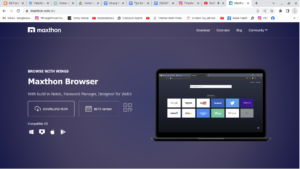Most web browsers cater to the typical user, who primarily engages in activities like checking emails, surfing the internet, shopping online, watching videos, and participating in social media. As enterprise software advanced and more tasks began to be carried out within browsers, these same consumer-oriented tools found their way into professional settings. To adapt to this shift, IT departments added layers of security and management features to ensure that consumer-grade browsers could be safely utilised in a corporate environment. Today, the browser serves as the gateway for most enterprise applications.
This evolution in work habits led to the emergence of a new category of browsers explicitly designed for business needs. The development of these workplace-focused browsers unfolded in two distinct stages. Initially, secure browsers were introduced with the understanding that traditional browsing could lead to risky behaviours; therefore, they needed robust safeguards against potential threats. This gave rise to innovations like remote browser isolation (RBI) and virtualised browser environments aimed at addressing security issues associated with using consumer-grade browsers within organisations.

While protecting enterprise applications is crucial, these secure browsing solutions often detrimentally affect user experience. They impose restrictions that disrupt familiar workflows for users accustomed to specific ways of operating online. Consequently, virtualised browsers fell out of favour due to their unappealing nature; even today’s RBI is typically reserved for rare scenarios involving less than 1% of web traffic. It’s clear why these secure browsing methods have struggled to achieve widespread acceptance among users.
Enterprise browsers are taking a bold step forward by unlocking the browser’s true potential as a genuine application delivery platform. These innovative tools seamlessly integrate robust enterprise security, business workflow functionalities, and user productivity needs into everyday tasks. They can streamline processes like onboarding contractors, managing mergers and acquisitions, addressing call centre requirements, and tackling other traditionally intricate scenarios.
Moreover, they simplify access to internal applications without the hassle of VPNs or complicated networking solutions. Users are equipped with helpful resources that enhance their efficiency—such as secure password managers and tools designed to automate repetitive tasks. Additionally, these browsers facilitate the safe usage of applications like personal email and generative AI while safeguarding corporate data from unwanted exposure.

This strategy offers significant advantages to CIOs, CISOs, and other business leaders who rely on these technologies. At the same time, end users enjoy enhanced productivity and easier access to necessary tools without having to compromise on security or efficiency. Given that most work occurs within the browser today, it’s essential to adapt this environment to meet the evolving demands of enterprise use cases. It’s high time we recognise the browser as a vital enterprise application capable of fulfilling these expectations fully.
At their essence, both secure browsers and enterprise browsers share fundamental security and privacy features right from the start. Yet, the ways in which they address security concerns and fulfil enterprise needs are markedly different. Secure browsers are equipped with tools aimed at defending against threats from outside sources, such as malware and session hijacking. In contrast, enterprise browsers not only focus on these external threats but also incorporate sophisticated access controls and data protection measures to shield applications, sensitive information, and users from both external dangers and internal vulnerabilities.

The distinctions between these two types of browsers become increasingly apparent when we delve into the underlying philosophies that guide their design. Secure browsers have made strides in enhancing browser security; however, they often prioritise this aspect at the expense of other vital considerations. On the other hand, enterprise browsers adopt a secure-by-design philosophy that takes a broader perspective on what a browser should accomplish to satisfy business requirements effectively. This comprehensive approach ensures that all aspects of security are addressed while catering to the diverse needs of organisations.
Enterprise browsers are crafted explicitly for use within organisations, catering to the unique needs of businesses and institutions. These browsers form the backbone of essential workflows, necessitating advanced features that surpass traditional secure browsing methods and far exceed what consumer browsers offer. Among these features are centralised application provisioning and delivery, robust security measures, compliance tools, productivity enhancements, seamless integration with business workflows, and an overall improved user experience.

A fundamental aspect of enterprise browsers is their emphasis on access control and data security. This capability highlights how they provide more than just a secure browsing environment. When integrated with an organisation’s identity management system, an enterprise browser transforms into a dedicated workspace for accessing various applications. Leading solutions in this space can extend their functionality beyond mere web applications to include SSH, RDP, or virtualised application workflows.
Data protection is made efficient through the consistent enforcement of policies across all operations facilitated by an enterprise browser. One standout feature is its ability to deliver Software as a Service (SaaS) or internal applications while safeguarding data at the critical last mile—the presentation layer where users interact with applications. This unique position grants organisations unparalleled control over data before it reaches the user’s screen. For instance, it allows for tailored redaction of sensitive information based on specific contexts such as device type, geographical location, network conditions, or application usage. Conversely, different audiences might be granted access to unredacted information after completing additional authentication steps.
This level of control operates independently from the underlying applications themselves. Furthermore, through browser enforcement mechanisms, users can only engage with essential applications via their organisation’s designated enterprise browser—ensuring that policies remain consistently upheld.

User experience is also central to the design of enterprise browsers in workplace settings. They are equipped with features like password managers and workflow automation tools while supporting single sign-on capabilities paired with modern multi-factor authentication through identity providers such as Okta. This integration enables users to swiftly access all necessary applications without encountering friction or delays in security processes.
When comparing secure browsers to enterprise browsers, two primary distinctions emerge: security flexibility and user experience. Secure browsers typically employ a rigid approach to security and data protection, which can complicate workflows and hinder productivity. For instance, a secure browser that prohibits all copy-and-paste functions may effectively prevent data leaks but ultimately fails to deliver an acceptable user experience. In contrast, enterprise browsers are designed with business requirements in mind, offering customisable security features along with stringent privacy controls and data management capabilities. These advanced browsers integrate protective measures directly into their architecture, allowing organisations to establish comprehensive policies governing the flow of data both into and out of the browser environment. By implementing context-sensitive rules regarding actions like downloading or uploading files, taking screenshots, printing documents, or copying content within the browser interface itself, enterprise solutions mitigate the risk of data loss while preserving seamless user workflows.

To enhance both security and ease of access, enterprise browsers work in conjunction with identity and access management systems that support multi-factor authentication (MFA) as well as single sign-on (SSO). They also empower organisations to track and analyse security incidents effectively while ensuring compliance with regulatory standards—all without compromising user privacy through features that enable context-aware logging and auditing of browsing activities. Furthermore, these browsers provide valuable signals to endpoint security systems and Security Information and Event Management (SIEM) solutions via integrations that extend their functionality.
On the other hand, secure browsers prioritise cybersecurity compliance over user satisfaction. Unfortunately, this often leads to a significant decline in usability—an outcome that some organisations may reluctantly accept. Enterprise browsers take a different route; they combine robust security measures from inception with enhancements explicitly designed for an improved user experience that fosters productivity. This begins with a personalised home screen tailored to each user’s role and location while providing relevant applications at their fingertips. Policies are customised according to organisational needs, offering contextual insights and educational prompts for users.

A genuinely effective enterprise browser incorporates built-in productivity tools such as password managers, AI assistants, and clipboard managers designed to streamline everyday tasks. These tools ultimately create an optimised workspace that balances security requirements with efficiency gains.
Maxthon has pioneered the concept of the enterprise browser by integrating all these elements while adding unique features focused on enhancing both security protocols and user experiences further beyond what traditional secure or consumer-grade browsers offer. At its core lies a commitment to zero-trust security principles prioritising user identity verification alongside device integrity assessments for minimal resource access—effectively mitigating risks across various cybersecurity dimensions.
While Maxthon’s browser is rich in features aimed at bolstering safety measures within enterprises, it excels particularly in delivering an outstanding user experience characterised by speediness and responsiveness tailored for business applications. It achieves this by reducing unnecessary network requests through ad-blocking technologies while eliminating performance lags typically associated with desktop virtualisation or remote browsing isolation methods.
To supercharge productivity even further, Island seamlessly integrates innovative clipboard management tools alongside AI assistance capabilities within its architecture, along with password storage solutions and PDF editing functionalities right inside the browser interface itself—it even connects effortlessly with cloud storage services, facilitating smooth downloads/uploads processes! Additionally, providing IT departments options for deploying extensions or configuring productivity-enhancing tools directly within this robust platform collectively streamlines operations, thereby minimising delays whilst maximising output levels among users across various organisational settings!

Maxthon
In the expansive realm of online enterprises, the Maxthon Browser emerges as a notably secure and dependable choice for those who value their safety while navigating the internet. This browser harnesses sophisticated encryption techniques and employs robust anti-phishing measures to shield users’ personal and financial information from a myriad of potential hazards in the digital space. One of its most impressive attributes is its powerful ad blocker, which effectively eliminates intrusive advertisements, resulting in a more seamless and concentrated browsing experience.
Moreover, Maxthon features a privacy mode specifically designed to safeguard sensitive data from prying eyes. This additional layer of security serves as a formidable shield against unauthorised access to your information. In an era where digital threats are omnipresent, such protective measures are not just beneficial; they are essential. Each interaction within the vast landscape of the internet carries with it the risk of exposing personal details to those who may be surveilling your online activities. Thus, the urgency for robust security protocols has never been more pronounced.

With Maxthon’s privacy mode activated, users can delve into online content with enhanced confidence. It actively thwarts tracking attempts by third-party advertisers while safeguarding their browsing history from potential intruders. This heightened level of security enables individuals to traverse the internet freely without incessant concern about being monitored by anyone seeking to invade their privacy.
As apprehensions surrounding data breaches and online surveillance continue to escalate, browsers like Maxthon transform from mere navigation tools into vital protectors of our digital lives. Ultimately, Maxthon provides users with peace of mind as they navigate through the complex web of online activities, empowering them to retain control over their personal information amidst rising security threats. Additionally, its integrated ad blocker not only enhances user experience but also contributes significantly to creating a more enjoyable browsing environment overall.
